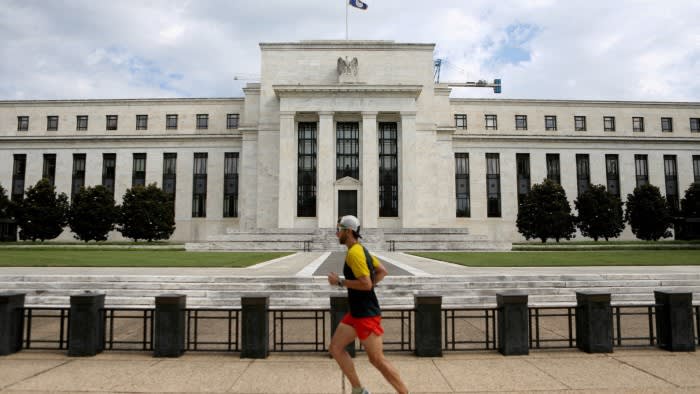Stay informed with free updates
Simply sign up to the US interest rates myFT Digest — delivered directly to your inbox.
Investors have sharply increased their bets on a half-percentage-point interest rate cut by the Federal Reserve next week, as the US central bank prepares to lower borrowing costs for the first time in more than four years.
Traders in swaps markets are currently pricing in a 43 per cent chance that the Fed will opt for a bumper cut in a bid to prevent high rates from damaging the economy.
On Thursday, they had priced in just a 15 per cent chance.
Mark Dowding, chief investment officer at RBC BlueBay Asset Management, said a half-point cut was now “very much in play” after having been “almost entirely priced out” at one point on Thursday.
Markets still ascribe a 57 per cent probability to a smaller quarter-point cut, but the likelihood of such a move is down significantly from Thursday.
On Thursday evening, the Financial Times and the Wall Street Journal reported that the Fed faces a close call on whether to go with a half-point or quarter-point cut.
Former New York Fed president Bill Dudley said on Friday that he saw a “strong case” for a half-percentage point cut next week, emphasising the restrictive impact on growth of the current rate of 5.25 per cent to 5.5 per cent, a 23-year-high.
The Fed typically moves in quarter-point increments, but a 0.5 percentage point cut could serve as a pre-emptive measure if officials feel the economy is at risk of slowing too quickly.
Some officials thought it “plausible” for the Fed to have lowered rates at its last meeting in July, minutes from that meeting showed, suggesting a larger move could help the central bank to catch up given that inflation has fallen further since then.
“The path of least regrets for the Fed is to lead with 50 [basis points],” said Tim Duy, chief US economist at SGH Macro Advisors. “It’s the only logical policy choice.”
Gabriele Foà, a fund manager at Algebris Investments, said the Fed was “better off . . . frontload[ing] cuts” rather than risk “falling behind the curve in a downturn”.
Wednesday’s Fed meeting, the last before November’s presidential election between Kamala Harris and Donald Trump, is highly charged as officials try to pilot the world’s biggest economy towards a “soft landing”, in which inflation is tamed without triggering a recession.
A closely watched survey from the University of Michigan showed that consumer expectations of inflation over the next year had fallen to 2.7 per cent, the lowest rate since late 2020. The university’s report on Friday also showed consumer sentiment for September rose to a four-month high.
The yield on two-year US Treasury bonds, which tracks interest rate expectations and moves inversely to prices, was down 0.05 percentage points to 3.6 per cent on Friday.
Stocks rose, with the S&P 500 index up 0.7 per cent and on track for its best weekly performance this year.
Analysts said the meeting was one of the most uncertain in years, after recent data presented a mixed picture of an economy with both some remaining price pressures and weakness in the labour market.
Figures this week showed headline inflation falling to 2.5 per cent — close to the Fed’s 2 per cent target — but core inflation rose more than expected by 0.3 per cent month on month, partly because of pressures in the housing market.
“If you’ve got remaining inflation lingering in the housing and shelter sector, a 50 basis point cut could potentially actually accelerate that or amplify that,” said Wylie Tollette, chief investment officer at Franklin Templeton Investment Solutions, who expects a quarter-point cut.
He added that the election could also complicate the case for a big cut.
Trump has suggested that a Fed rate cut would help Harris as the incumbent vice-president, “even though it’s something that they know they shouldn’t be doing”.
Tollette added: “The Fed’s path is that they want to do what’s right for the economy, but I don’t think they want to be perceived as benefiting the incumbent candidate by cutting more aggressively.”
But, with unemployment rising and demand slowing, Fed officials want to prevent the labour market from weakening further.
Fed Chair Jay Powell said last month the central bank would “do everything we can to support a strong labour market as we make further progress towards price stability”.
Salman Ahmed, global head of macro at Fidelity International, said: “It’s a cat-and-mouse game . . . we have started the cutting cycle, but a lot about it remains to be determined.”
He added that for most of the post-pandemic cycle it had become “abundantly clear that neither the market nor the Fed has any idea what the Fed will do”.
Last December, Fed forecasts signalled 75 basis points of cuts during 2024 — but by June it suggested it would only make one quarter-point cut for the year.
Additional reporting by Kate Duguid and Laurence Fletcher
https://www.ft.com/content/a6e5cafe-01fa-4291-a7ba-f2b132ef6879


